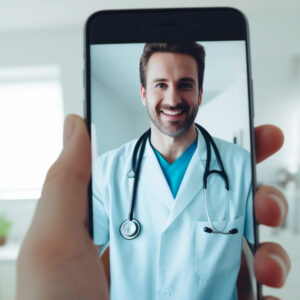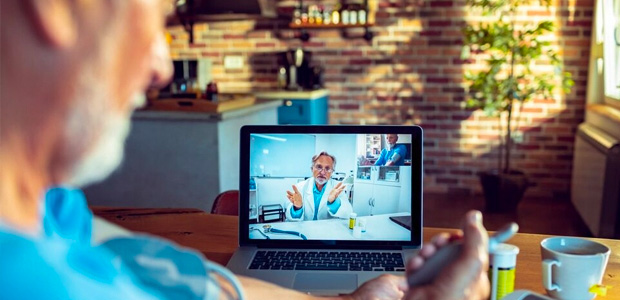
These technologies are enabling more convenient, accessible and affordable healthcare delivery. For healthcare providers, understanding the virtual care landscape is crucial to meet shifting consumer preferences and remain competitive.
Virtual care technologies like telehealth, remote monitoring, patient engagement platforms, computer vision, wearables, and robotics are transforming healthcare delivery. Providers should look to integrate evidence-based virtual care solutions into workflows to improve access, coordination, diagnostics, chronic disease management, and patient outcomes. However, they must ensure these technologies are accurate, reliable, interoperable with existing tools, and used ethically to augment —not replace—human expertise. Adopting virtual care thoughtfully can make care more convenient, personalized and effective for patients.
This article explores the key virtual care technologies that providers should understand.
Telehealth
Telehealth involves delivering clinical services like diagnosis, treatment, education and monitoring remotely using technology. It allows patients to access healthcare services without having to visit a clinic or hospital in-person.
Telehealth can be provided through various modalities:
- Video conferencing: Real-time audio-video connection between provider and patient. Allows visual cues and rapport building. Popular platforms include Doxy.me, VSee, Zoom, Microsoft Teams and Google Meet.
- Store and forward: Collecting medical data like images or videos and transmitting them to providers for evaluation later. Allows asynchronous care. Platforms include Teladoc, MDLive and Zipnosis.
- Remote patient monitoring (RPM): Patients use connected devices to collect health data like blood pressure, heart rate, etc. and transmit it to providers in real-time. Allows regular monitoring between office visits. Popular RPM devices and apps include TytoHome, Vivify Health, Biofourmis, Apple HealthKit.
- Chatbots and symptom checkers: Automated chatbots or symptom checkers can offer basic triage services, answer health questions and provide follow-up instructions. Apps like Babylon, Ada and Your.MD use AI.
- Messaging: Secure clinician-patient messaging can be used for quick consults, prescription refills, lab results and scheduling. Providers should have HIPAA-compliant messaging integrated with EHR.
Telehealth benefits include improved access to care, patient convenience, reduced costs, better outcomes for chronic conditions and increased patient engagement. Providers should offer telehealth services to remain competitive, while ensuring they have clear telehealth policies and follow clinical guidelines and regulations when delivering virtual care.
Hybrid Care Models
Many healthcare organizations are moving towards “hybrid care” models that seamlessly integrate virtual and in-person care across all settings (outpatient, inpatient, emergency, etc).
Some key technologies enabling hybrid care include:
- Integrated EHR: A single connected EHR across care settings allows providers access to full patient records during virtual and in-person visits. Look for easy scheduling, documentation and billing across platforms. Epic and Cerner lead EHR integration.
- Telemedicine carts: Carts with cameras, monitors and peripherals allow providers to smoothly transition between in-person and virtual care, maintaining continuity. Popular options are from Avizia, AMD Global, DetectFlatten.
- Digital patient engagement platforms: These facilitate patient communication, prescription management, remote monitoring and self-service options like scheduling and bill pay. Leading options are MyChart, FollowMyHealth, GetWellNetwork.
- Remote patient monitoring: As mentioned earlier, RPM integrated across care settings allows regular data collection and clinician oversight between in-person visits. Providers can intervene early for deteriorating conditions.
When implementing hybrid care models, providers should focus on seamless workflows, tech-enabled collaboration between virtual and in-person teams, clear data sharing protocols and policies that maintain continuity of care.
Patient Portals
A patient portal is a secure online website that gives patients 24/7 access to their personal health information and medical records from anywhere. This promotes patient engagement, satisfaction and informed decision-making.
Main portal functions include:
- Booking appointments, prescription refills, messaging providers
- Accessing lab/imaging results, visit summaries, immunization records, discharge instructions
- Secure video visits with providers through telehealth integration
- Completing intake forms, screeners, consent forms
- Paying bills online
Leading patient portal solutions like MyChart, FollowMyHealth, and NextGen Patient Portal are integrated with EHRs like Epic and Cerner. Providers should actively educate patients on using portals to manage their health and consistently promote portal enrollment.
Remote Diagnostics
Many diagnostic tests can now be performed remotely using specialized connected devices and apps:
- Digital pathology: Scanning tissue samples to transmit digitally to pathologists for analysis. Improves specialist access. Solutions include Mikroscan, Ibex, Philips, Leica Biosystems.
- Retinal imaging: Taking retinal images to screen for conditions like diabetic retinopathy and age-related macular degeneration (AMD). Can be done remotely with handheld cameras like Welch Allyn PanOptic, 3nethra neo. Images transmitted to ophthalmologists for evaluation.
- Ultrasound probes: Portable probes like Butterfly iQ allow generalist providers to capture ultrasound images on their smartphones and consult remotely with specialized radiologists.
- Spirometers: Devices like NuvoAir that attach to smartphones can do remote lung function testing. Results are sent to respiratory therapists.
- ECG monitoring: Wireless patches like iRhythm Zio monitor heart rhythm for weeks and transmit findings to cardiologists.
- Smartphone endoscopes: Micro-cameras like MedWand on providers’ smartphones enable visual examination of nose, throat, ears etc. and live consultation with specialists.
These devices improve access to specialists, reduce unnecessary transfers, speed up diagnoses and allow remote monitoring. Providers should identify technologies that enhance expertise access and diagnostic capabilities.
Chronic Care Management Software
Managing patients with chronic conditions like diabetes, COPD, hypertension, etc., is a central challenge in healthcare. Chronic care management (CCM) software helps providers deliver ongoing coordinated care, remotely.
Key features include:
- Patient databases to identify and stratify high-risk patients needing increased care coordination.
- Evidence-based care plans personalized to patients’ needs and conditions. Care plan compliance tracking.
- Regular automated remote monitoring of health metrics like glucose levels, blood pressure, medication adherence. Alerts for deteriorating health.
- Education resources on chronic conditions and self-management.
- Secure messaging for provider-patient communication.
Leading CCM platforms like DarioHealth, Wellframe and CareManage engage patients daily and allow providers to deliver customized proactive interventions to improve chronic disease outcomes. Providers should look for CCM software that integrates with their EHR/population health tools for whole-person care across settings.
Digital Therapeutics (DTx)
Digital therapeutics (DTx) are evidence-based therapeutic interventions delivered through software programs to prevent, manage, or treat a medical disorder. They are reviewed and cleared by regulatory bodies. DTx uses science-backed techniques like behavioral cognitive therapy, AI and smart data analytics to drive behavior change and improve clinical outcomes.
Examples include:
- Cognitive behavioral therapy apps for depression, anxiety, substance abuse (CBTi Coach, Mindable Health)
- Digital pills that track adherence via sensors (Abilify MyCite antipsychotic)
- Diabetes management apps linked to glucose meters (One Drop)
- Insomnia treatment apps with sleep tracking (Sleepio)
- Substance abuse apps using neurobehavioral interventions (reSET-O for opioid use)
- Stroke rehabilitation apps using EEG data (Constant Therapy)
DTx can increase patient access to cost-effective high-quality treatment options. Providers should recommend validated DTx and integrate its use into overall care plans, monitoring progress through outcome dashboards. Yet, DTx should complement in-person therapies, not fully replace them.
Computer Vision & AI
Computer vision and AI techniques are automating analysis of complex medical imaging and data to improve efficiency, accuracy and consistency in diagnosis and treatment.
Applications include:
- AI-assisted imaging analysis: Algorithms can process thousands of scans identifying lesions, tumors and abnormalities more quickly and precisely than humans. Vendors like Zebra, Aidoc, Arterys.
- Automated image segmentation: Software can isolate organs and anatomies from medical images to highlight findings. Improves surgery/radiation therapy planning. Examples are Avicenna.ai, Nines.
- AI doctor support: Platforms like Isabel, HumanDX, Babylon use algorithms to synthesize patient information and suggest possible diagnoses to physicians.
- Voice-enabled documentation: Solutions like Saykara use AI to automatically transcribe physician-patient conversations into medical notes with high accuracy.
While AI holds great promise, providers must ensure these technologies integrate safely into clinical workflows and undergo rigorous regulatory review for effectiveness and risks. AI should augment human expertise, not replace provider judgement.
Blockchain for Health Data
Blockchain is a distributed digital ledger technology that establishes trust and transparency by decentralizing record-keeping.
It has emerging applications in healthcare like:
- Health information exchanges: Sharing data securely between unaffiliated providers. Startups like Hashed Health, Doc.ai, Patientory.
- Supply chain monitoring: Tracking medications and medical devices to prevent counterfeits entering supply chain and ensure product quality. Chronicled, FarmaTrust.
- Clinical trials: Improved data integrity, security and transparency in recording patient consent, trial processes and results. Companies like MedRec, Nuggets, Ambrosus.
- Patient identity and control: Patients control access to their records across institutions through private keys. Solutions like Nebula Genomics, SimplyVital.
Blockchain benefits include immutability, transparency, privacy, security and decentralization. However, providers should ensure solutions are interoperable with current health IT systems. Key challenges still exist around patient data privacy, scalability, standardization and regulatory policies. But blockchain could potentially transform data sharing and integrity in healthcare.
Wearable Devices
Wearable medical devices allow continuous, real-time monitoring and transmission of patient health data.
Devices like smartwatches, patches, headbands and clothing integrate sensors to track:
- Vital signs like heart rate, respiration, temperature, blood oxygen, blood pressure
- Physical activity and quality of sleep
- Cardiac abnormalities like arrhythmia, atrial fibrillation
- Glucose levels, posture, falls, seizures
Major medical wearable companies include Apple, Fitbit, Samsung, Withings, Omron, BioTelemetry. Providers can monitor patient health data remotely through connected apps and digital dashboards to inform interventions. But accuracy, reliability, integration with EHRs and patient comfort/adherence remain key considerations.
Robotics (Bots)
Healthcare robotics involve machines assisting with surgical procedures, disinfection, pharmaceutical dispensing, patient monitoring and companionship.
Key applications include:
- Robotic surgery: Systems like daVinci allow more precise, minimally invasive surgery through small incisions. Improves recovery.
- Telepresence robots: Let remote physicians digitally round on patients, staff from their computer. Companies like InTouch Health, OhmniLabs.
- Disinfection robots: Use UV light to kill pathogens in patient rooms, reducing hospital acquired infections. Bioquell, Xenex.
- Exoskeletons: Wearable robotic devices enable limb movement recovery in stroke, spinal cord injury rehabilitation. SuitX, Ekso Bionics.
- Medication management: Robots from firms like BD Rowa, Arxium and McKesson automate high-volume medication dispensing reducing errors.
- Companion robots: Paro the seal, ElliQ, Mabu the robot – provide social interaction to reduce loneliness in elderly.
While still emerging, providers can look at evidence-based ways to integrate robotics into clinical workflows to improve patient outcomes, satisfaction and access.
Summary
Virtual care technologies have transformed healthcare delivery models. Providers today need awareness of this landscape to identify promising digital health solutions while navigating inherent risks and limitations. Key considerations include evidence of improved outcomes, technology reliability and accuracy, integration with existing workflows and tools, patient comfort and ethical use.
By judiciously adopting telehealth, data analytics, AI, wearables and other emerging medical technologies, providers can make care more convenient, personalized and impactful for patients in the digital era.
